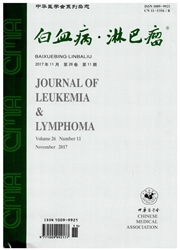

 中文摘要:
中文摘要:
目的以人类白血病细胞株K562为研究对象,探讨BH3模拟物s1诱导人类白血病细胞凋亡的机制。方法通过XTT法检测s1作用下K562细胞的生存率;S1作用不同时间,流式细胞术检测细胞凋亡率;分光光度法检测Caspase-3、-8、-9激活;免疫共沉淀检测s1作用后bax、bak释放情况。结果与对照组相比s1能够以时间和浓度依赖的方式诱导K562细胞凋亡,24h的IC50值为13.5μmol/L;流式细胞术结果显示,s1处理12h后K562细胞出现大量早期凋亡,时间延长至24h后,晚期凋亡比例显著增加;S1通过激活Caspase-3、-9而不是Caspase培诱导K562细胞通过内源凋亡通路进行凋亡;免疫共沉淀实验检测5μmol/L的s1处理8h后K562细胞中的抗凋亡蛋白bcl-2和mcl-1受到s1的拮抗,促凋亡蛋白bax和bak分别从抗凋亡蛋白bcl-2和mcl—1上得到释放。结论s1可能通过拮抗bcl—2、mcl-1蛋白释放bax、bak诱导人类白血病细胞凋亡。
 英文摘要:
英文摘要:
Objective To investigate the apoptosis mechanism induced by BH3 mimetic S1 in human leukemia cell line K562. Methods Cell viability was detected by XTT to S1 in leukemia cell line K562. K562 cells was incubated with S1 for different time, the apoptosis rate of K562 cells was determined by flow cytometry analysis. Caspase-3, -8, and -9 activities were measured by absorption spectra. Co-immunoprecipitation was used to analyze the releasing of bax, bak from bel-2 and mcl-1. Results Compared with control group,a dose-dependent increase in apoptosis coincided with a dose-dependent decrease in cell viability following S1 treatment suggested that S1 inhibits cell proliferation through the induction of apoptosis. The ICso value at 24 h for S1 was 13.5 μmol/L. Exposure of K562 cells to S1 for 12 h resulted in a time-dependent increase in FITC-Annexin-positive/PI-negative early apoptotic cells. The strong increase of FITC Annexin/Pl double- positive cells after a 24 h treatment indicated a shift to late apoptosis. SI activated Caspase-3 and -9, but not Caspase-8 indicated that S1 induced K562 cells apoptosis via the intrinsic pathway. K562 cells treated with 5 μmol/L of S1 showed a disruption in bcl-2/bax, mcl-1/bak complexes after 8 h S1 treatment. Conclusion The main mechanism that S1 induces K562 cells apoptosis might be through the inhibition of bcl-2/bax, mcl-1/bak complexes dissociation.
 同期刊论文项目
同期刊论文项目
 同项目期刊论文
同项目期刊论文
 期刊信息
期刊信息
